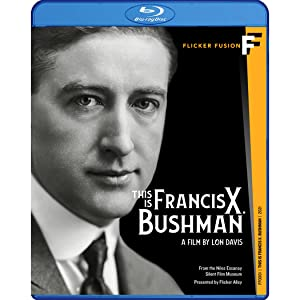THIS IS FRANCIS X BUSHMAN
(director/writer: Lon Davis; screenwriter: Debra Davis/from the book King of the Movies: Francis X. Bushman by Don and Debra Davis; editors: Zack Sutherland/Nate Sutton; music: Richard Chon/Frederick Hodges; cast: Chris Bushman (Narrator), Francis X Bushman; Runtime: 60; MPAA Rating: NR; producer: Lon Davis; TCM/Flicker Alley; 2021 B/W)
“If we believe this biopic, Bushman had some flaws but was basically a decent man.”
Reviewed by Dennis Schwartz
First-timer Lon Davis directs the non-critical, no-nonsense, conventional biopic documentary on the colorful life of the legendary silent film star Francis X. Bushman (1883-1966), who was born in Baltimore, Maryland. It’s narrated by his idol-worshiping grandson, the Oscar-winning technician Chris Bushman, as we see the film clips of his grandfather as actor and director of the few remaining films of the 200 he made that weren’t destroyed by fire or decay. Many of the clips shown were never-before-seen. We learn Bushman was a big spender, loved the ladies (had 4 marriages), had a tremendous female fan base and went from world-wide fame during the silents to near obscurity in modern-times.
The actor’s story begins with him being a model for sculptors making bronze statues of him as a strongman. He gets recruited to Chicago to work for Essany Studios on silents, where through the factory system he can make 2 or 3 quickie films in a week (most of these films were destroyed). In 1911 he’s a popular matinee idol (in fact, he’s the most popular actor at this time and Mary Pickford the most popular actress), who was known for His Friend’s Wife. Because of his muscular physique he becomes a favorite of the ladies. In Hollywood, in 1925, he gets the part of his life in Ben Hur. For the famous chariot race scene, he has no double as he races in the coliseum with the film’s star Ramon Novarro playing the hero Ben Hur, while he’s the bad guy Messala.
The MGM head Louis B. Mayer had a hatred for Bushman after Ben Hur and had him blacklisted from the top studios for demanding his back pay of $17,000 in a room full of other Hollywood people and probably for some other unknown reasons the asshole studio head had. When talkies came into play Bushman worked for small studios, poverty-row studios and did radio programs, including ones for Orson Welles (who greatly admired him as an actor).
Bushman lost his vast property and expensive dream house in Maryland. But was always resilient and always found work until his last days. From the 1950s on he became a folksy and well-liked personality, who made guest appearances on top-line TV shows like The Burns and Allen show and on Bob Hope’s show.
He also appeared in talkie films like Sabrina (1954) and The Phantom Planet (1961).
The film offered no serious critique of Bushman and made no attempt to make sense of its complex subject’s life. Instead the film gives us a laundry-list of the silent star’s films and his life path, but offers little depth on its star of the silents. If we believe this biopic, Bushman had some flaws but was basically a decent man.

REVIEWED ON 6/15/2023 GRADE: B